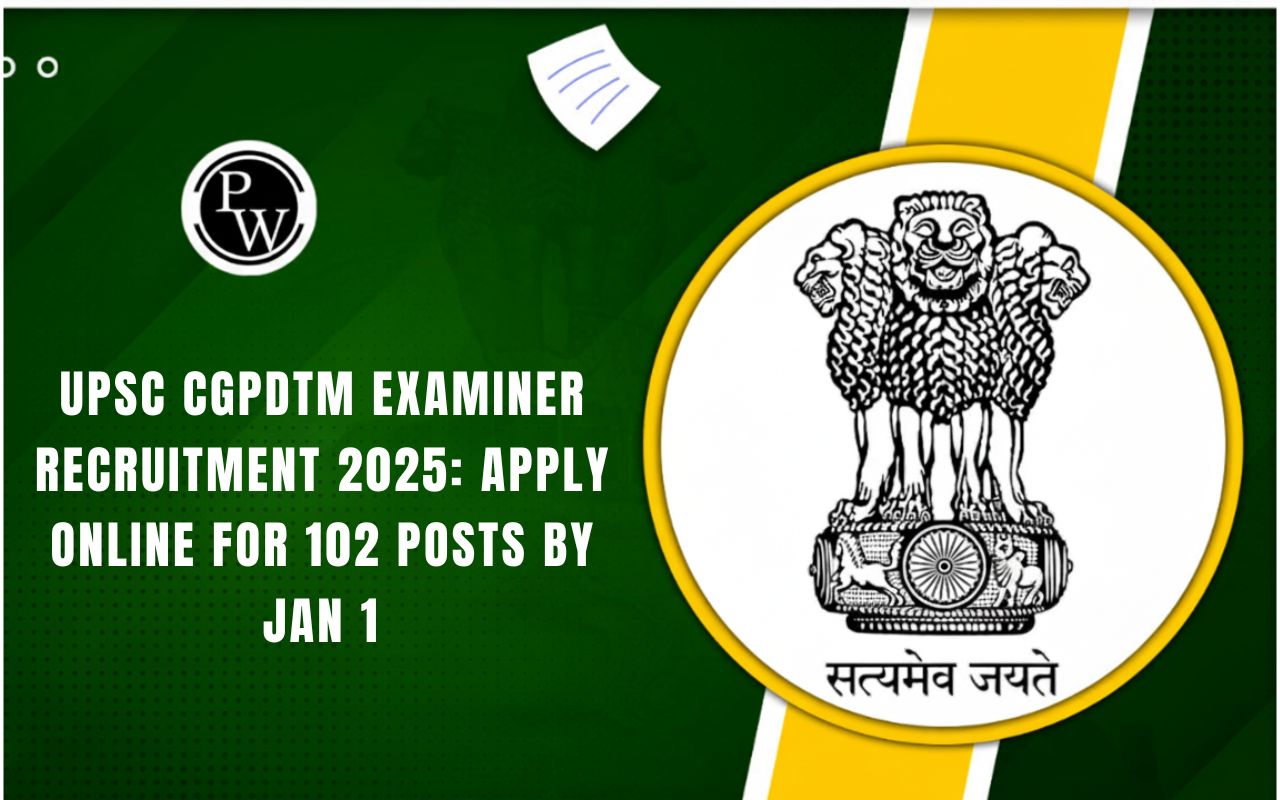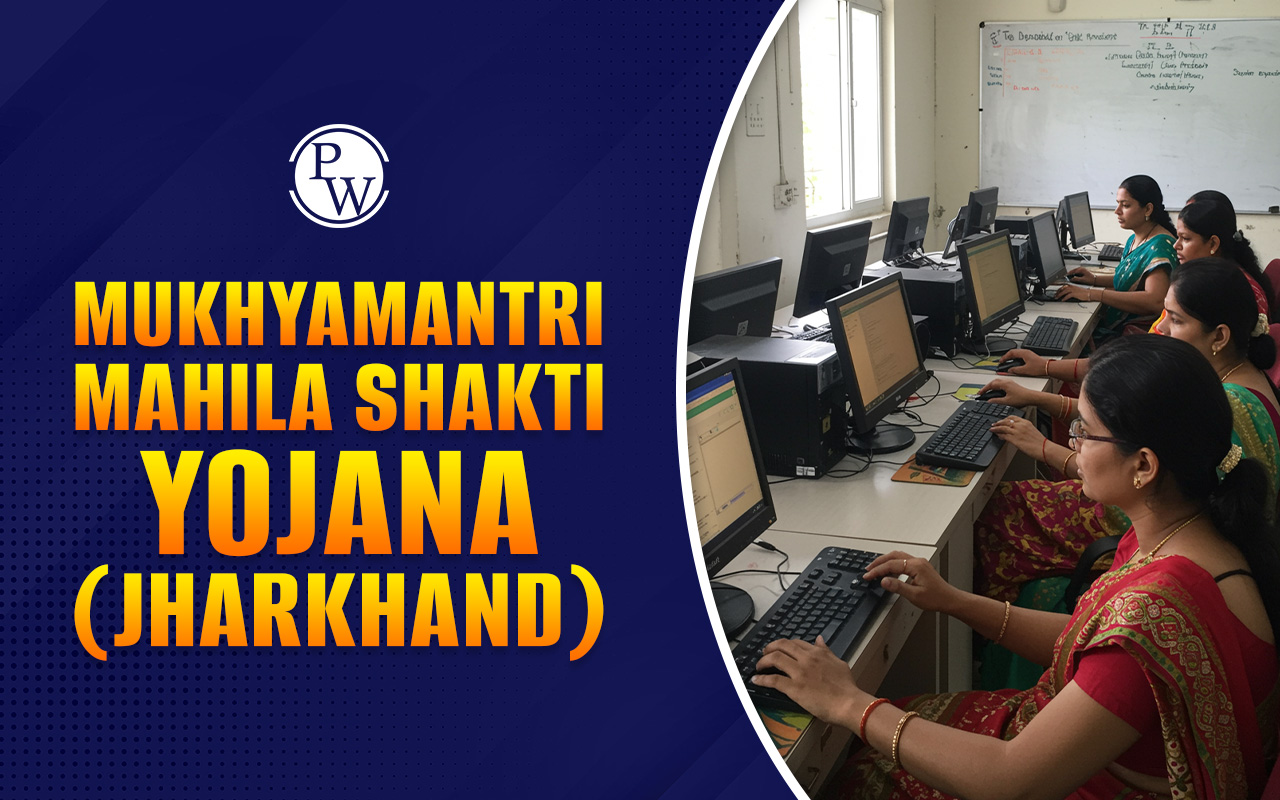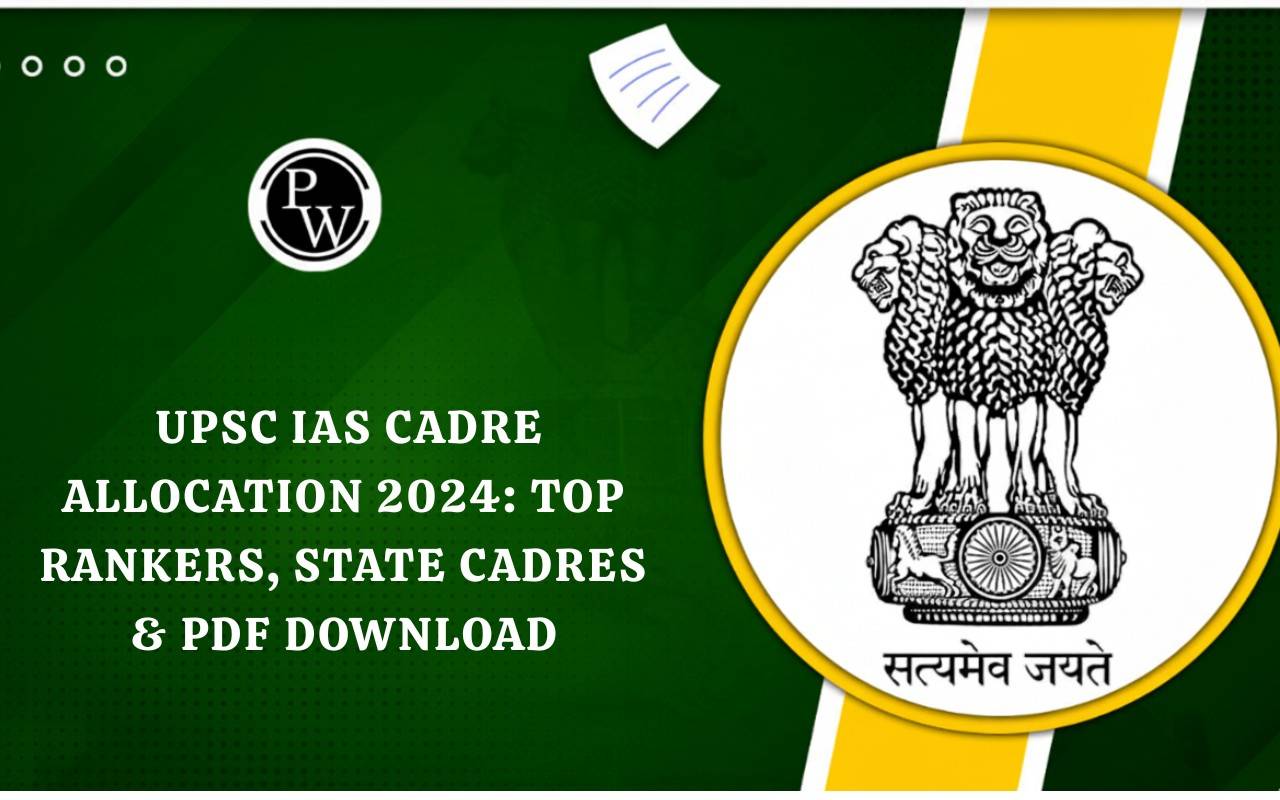
UPSC Prelims Exam Analysis 2025 has been provided by PW ONLYIAS as the UPSC Civil Services Prelims 2025 exam for GS Paper 1 and CSAT, following the exam on May 25, 2025. This analysis suggests the exam was moderate, with a balanced mix of questions across various subjects.
While GS Paper 1 focused on analytical and interpretative questions, CSAT had lengthy and tricky questions. Read on for UPSC Prelims Exam Analysis 2025, having a detailed breakdown of the question paper, including subject-wise weightage, difficulty level, and trend comparison with previous years!
UPSC Prelims Exam 2025 Overview
The UPSC Prelims 2025 comprised two objective-type papers conducted on the same day in two separate shifts. General Studies Paper I is merit-determining and crucial for shortlisting candidates for Mains, whereas CSAT (General Studies Paper II) is qualifying in nature, requiring a minimum of 33% to pass. Below is a quick overview:
|
UPSC Prelims Exam 2025 Overview |
||||
|---|---|---|---|---|
| Paper | Nature | Marks | Qualifying Criteria | Purpose |
| General Studies Paper I | Merit-Based | 200 Marks | No minimum marks, merit-based | Decides eligibility for Mains |
| General Studies Paper II (CSAT) | Qualifying Only | 200 Marks | Minimum 33% required (66 marks) | Must be cleared to qualify Prelims |
| Question Type | Objective (MCQs) | – | – | Conducted in two separate shifts |
| Exam Mode | Offline (Pen & Paper) | – | – | OMR-based marking system |
UPSC Prelims Exam Analysis 2025 – GS Paper 1
The General Studies Paper 1 of UPSC Prelims 2025 maintained a balanced structure while subtly shifting emphasis toward certain subjects. Candidates found Polity and Environment to be more prominent, while areas like Economy required deeper analysis. A noticeable integration of current affairs with traditional topics was evident throughout the paper.
Below is the subject-wise analysis of GS Paper 1 based on UPSC Prelims Exam Analysis 2025:
|
UPSC Prelims Exam Analysis 2025 – GS Paper 1 |
|||
|---|---|---|---|
| Subject | Total Questions | Difficulty Level | Nature of Questions |
| Ancient India | 6 | Easy to Moderate | Factual and conceptual |
| Medieval India | 2 | Easy to Moderate | Direct and factual |
| Modern India | 9 | Easy to Moderate | Mostly static questions. |
| Art & Culture | 1 | Easy to Moderate | Static questions with linkages to current themes. |
| Indian Polity | 14 | Moderate | Application-based questions |
| Indian Economy | 14 | Easy to Moderate | Conceptual, with some calculation-based questions. |
| Environment | 7 | Moderate | Questions connected with recent developments. |
| Geography | 13 | Moderate to Difficult | Analytical and map-based |
| Science & Technology | 13 | Easy to Moderate | Covered basic tech developments. |
| Current Affairs & Miscellaneous | 23 | Moderate | Trend-based and dynamic in nature. |
| Total | 100 | Moderate | Challenging, time-consuming, and demanding a solid grasp of the concepts. |
UPSC Prelims GS Paper 1 Exam Analysis 2025 Key Observations
The UPSC Prelims GS Paper 1 in 2025 reflected some significant trends and subtle shifts in question distribution and focus areas. A blend of static and current affairs was visible, with certain sections carrying more weight than usual. Here's a breakdown of the key observations:
- Moderate to Difficult: The paper struck a balance between factual recall and application-based questions, challenging candidates with multi-statement scenarios that demanded analytical thinking.
- Emphasis on Analytical Skills: About 67% of the questions featured multi-statement formats, shifting the focus from memorization to critical evaluation.
- Time Management Demands: Lengthy comprehension passages and intricate logical reasoning in CSAT (Paper II) made effective time allocation crucial.
- Application-Based Focus: Questions tested knowledge of government schemes (e.g., ethanol blending targets) and economic indicators.
- Current Affairs Integration: Topics like the Kho Kho World Cup and green hydrogen initiatives appeared indirectly.
- Focus on Conceptual Clarity: Prioritize understanding over memorization, especially for multi-statement and assertion-reasoning formats.
UPSC Prelims Exam Analysis 2025 – CSAT
The CSAT paper maintained its trend of being a qualifying yet challenging hurdle. While the basic structure remained unchanged, the complexity of questions and lengthy comprehension passages made the paper tougher for many aspirants. Here is an analysis of the CSAT paper:
|
Section |
Questions |
Difficulty Level |
|
Reasoning Ability |
17 |
Moderate |
|
Reading Comprehension |
29 |
Moderate to Difficult |
|
Numerical Ability |
34 |
Moderate |
|
Total |
80 |
Moderate to Difficult |
UPSC Prelims Analysis 2024
The UPSC Prelims Subject-wise Analysis 2024 is available for Paper 1 (GS) and Paper 2 (CSAT):UPSC Prelims Analysis 2024 GS Paper
The UPSC Prelims GS Paper, also known as Paper 1, was held in the morning shift of 9:30 to 11:00 AM. There were a total of 100 moderately challenging mixed questions. The UPSC Prelims question paper primarily focused on Polity, Geography, and Current Affairs. This year's GS paper has provided some relief to the students by reverting to its old pattern and being on the easier side. Find an in-depth analysis of the question paper, including the exact difficulty level and the type of questions in the table below:| UPSC Prelims Analysis 2024 GS Paper | |||
| Subjects | Total Questions | Difficulty Level | Type |
| Polity | 18 | Easy to Moderate | Application Based |
| Economy | 15 | Moderate | Application Based |
| History | 9 | Moderate to Difficult | Static |
| Science & Technology | 9 | Easy | Application Based |
| Geography | 19 | Easy to Moderate | Static |
| Environment | 10 | Moderate | Application Based |
| Current Affairs /Misc. | 20 | Easy to Moderate | Application Based |
| Total | 100 | Moderate | Mostly Application Based |
UPSC Prelims Analysis 2024 CSAT
The UPSC Prelims CSAT 2024 paper was held in the afternoon shift from 2:30 PM to 4:30 PM. Candidates were required to solve 80 questions worth 200 marks from the RC, Reasoning, and Numerical Ability sections. The target for this paper is scoring above 33% marks. The difficulty level and distribution of questions can be found in the table below:| UPSC Prelims Analysis 2024 CSAT | |||
| Subjects | Total Number of Questions | Good Attempt | Difficulty Level |
| Reasoning Ability | 35-40 | 21-26 | Moderate |
| Reading Comprehension | 22-24 | 14-17 | Moderate |
| Numerical Ability | 23-25 | 15-18 | Moderate |
| Total | 80 | 50-61 | Moderate |
Subject Wise UPSC Prelims Exam Analysis 2024
Subject Wise UPSC Prelims Analysis 2024 is essential to understand the number of questions asked in each section and the weightage given to the particular subject. This helps in making a preparation strategy as per the requirements of the exam. The UPSC GS Paper 2024 analysis suggests that this year's paper was moderate in difficulty. Here is the subject-wise UPSC Prelims 2024 question paper analysis:UPSC Prelims Exam Analysis 2023
The UPSC 2023 exam cycle is completed, and prelims cut off has been announced. It is evident from the cut off that the paper was highly difficult this year compared to previous years. This time, both GS and CSAT saw a new pattern of questions. The UPSC Prelims cut off stood at 75.41 for the general category due to the tough GS and CSAT paper. The UPSC Prelims Exam Analysis 2023 suggests that the new pattern of MCQs further makes it challenging to apply the elimination technique to the majority of questions. Additionally, some questions were purely factual and memory-based. The UPSC Prelims 2023 analysis subject-wise is provided in the table below for GS and CSAT.| UPSC Prelims Exam Analysis 2023 | ||
| UPSC Prelims Analysis 2023 - Paper 1 (GS) | ||
| Subjects | Total Questions | Difficulty Level |
| Polity | 14 | Easy to Moderate |
| Economy | 14 | Moderate to Difficult |
| Modern History | 3 | Moderate to Difficult |
| Ancient, Medieval History and Culture | 10 | Difficult |
| Science & Technology | 5 | Moderate |
| Geography | 9 | Moderate |
| Environment | 21 | Moderate to Difficult |
| Current Affairs /Misc. | 24 | Moderate |
| Total | 100 | Difficult |
| UPSC Prelims Analysis 2023 - Paper 2 (CSAT) | ||
| Reasoning Ability | 13-14 | Moderate to Difficult |
| Reading Comprehension | 27 | Moderate |
| Numerical Ability | 39-40 | Difficult |
| Total | 80 | Difficult |
UPSC Prelims Exam Analysis 2022
The UPSC Prelims 2022 was moderate to difficult overall. While some traditional sections were difficult, a few sections were comparatively easier than the previous year. History questions remained factual and memory-based; in politics, a few questions could be easily answered with good fundamental knowledge. The numerical ability section of the CSAT was difficult in nature. Check the subject-wise UPSC Prelims Exam Analysis 2022 for GS and CSAT papers below:| UPSC Prelims Exam Analysis 2022 | ||
| UPSC Prelims Analysis 2022 - Paper 1 (GS) | ||
| Subjects | Total Questions | Difficulty Level |
| Polity | 13 | Moderate to Difficult |
| Economy | 17 | Moderate to Difficult |
| Modern History | 4 | Moderate |
| Ancient and Medieval History | 5 | Difficult |
| Art & Culture | 7 | Difficult |
| Science & Technology | 14 | Moderate |
| Geography | 12 | Moderate |
| Environment | 17 | Moderate |
| International Relations | 11 | Moderate |
| Total | 100 | Moderately Tough |
| UPSC Prelims Analysis 2022 - Paper 2 (CSAT) | ||
| Reasoning Ability/Data Sufficiency | 21 | Moderate to Difficult |
| Reading Comprehension | 28 | Easy to Moderate |
| Numerical Ability | 31 | Moderate to Difficult |
| Total | 80 | Moderate to Difficult |
UPSC Prelims Exam Analysis 2021
In the UPSC Prelims Exam 2021, after a long gap, the sports section made a comeback in the GS paper. Some science questions were factual and difficult to answer, while a few could be answered with current knowledge. In this paper, time management and knowing what to leave were crucial factors in decision-making. The CSAT difficulty level started to increase in this year’s paper. Check out the below table for subject-wise distribution of questions based on the UPSC Prelims Exam Analysis 2021:| UPSC Prelims Exam Analysis 2021 | ||
| UPSC Prelims Analysis 2021 - Paper 1 (GS) | ||
| Subjects | Total Questions | Difficulty Level |
| Polity | 17 | Easy to Moderate |
| Economy | 14 | Moderate |
| History | 18 | Difficult |
| Art & Culture | 3 | Difficult |
| Science & Technology | 12 | Moderate to Difficult |
| Geography+Agriculture | 9 | Easy to Moderate |
| Environment | 21 | Moderate to Difficult |
| Sports/Misc. Current Affairs | 6 | Difficult |
| Total | 100 | Moderately Tough |
| UPSC Prelims Analysis 2021 - Paper 2 (CSAT) | ||
| Reasoning Ability | 21 | Moderate |
| Reading Comprehension | 27 | Moderate to Difficult |
| Numerical Ability | 24 | Difficult |
| Misc. | 8 | Moderate to Difficult |
| Total | 80 | Moderately Tough |
UPSC Prelims Exam Analysis 2020
The UPSC Prelims Exam Analysis 2020 suggests that the overall question paper was moderate. While the GS paper was comparably more difficult than previous years, some sections, like Polity and Economy, can be attempted with good preparation. In CSAT, a trend of moderate to difficult questions was observed this year. The table below presents a subject-wise analysis of UPSC Prelims 2020:| UPSC Prelims Exam Analysis 2020 | ||
| UPSC Prelims Analysis 2020 - Paper 1 (GS) | ||
| Subjects | Total Questions | Difficulty Level |
| Polity | 14 | Easy to Moderate |
| Economy | 14 | Moderate to Difficult |
| History and Art and Culture | 19 | Moderate to Difficult |
| Science & Technology | 10 | Easy to Moderate |
| Geography | 13 | Moderate to Difficult |
| Environment | 11 | Moderate to Difficult |
| Current Affairs | 19 | Moderate to Difficult |
| Total | 100 | Moderate |
| UPSC Prelims Analysis 2020 - Paper 2 (CSAT) | ||
| Reasoning Ability | 16 | Easy to Moderate |
| Reading Comprehension | 25 | Moderate to Difficult |
| Numerical Ability | 39 | Moderate to Difficult |
| Total | 80 | Moderate |
UPSC Prelims Exam Analysis 2019
The UPSC Prelims 2019 paper was comparably more difficult than the 2018 paper due to some lengthy questions. The polity section remained on the difficult side, along with history. However, questions of economy and science could be solved with decent knowledge of current affairs. The CSAT paper was overall moderate, with a few easy reasoning questions. The UPSC Prelims Exam Analysis 2019 is presented in the following table:| UPSC Prelims Exam Analysis 2019 | ||
| UPSC Prelims Analysis 2019 - Paper 1 (GS) | ||
| Subjects | Total Questions | Difficulty Level |
| Polity | 15 | Moderate to Difficult |
| Economy | 14 | Easy to Moderate |
| History+Art & Culture | 17 | Difficult |
| Science & Technology | 7 | Moderate to Difficult |
| Geography | 14 | Moderate to Difficult |
| Environment | 11 | Moderate |
| Current Affairs | 22 | Moderate to Difficult |
| Total | 100 | Moderate |
| UPSC Prelims Analysis 2019 - Paper 2 (CSAT) | ||
| Reasoning Ability | 18 | Easy to Moderate |
| Reading Comprehension | 30 | Moderate |
| Numerical Ability | 32 | Moderate to Difficult |
| Total | 80 | Moderate |
UPSC Prelims Exam Analysis 2018
The trend of difficult and factual history questions started in 2018. This year, traditional subjects were mostly difficult but doable with good practice and the application of elimination methods. In the CSAT paper, many data interpretation (DI) questions were seen. Here is a subject-wise analysis of the 2018 question papers.| UPSC Prelims Exam Analysis 2018 | ||
| UPSC Prelims Analysis 2018 - Paper 1 (GS) | ||
| Subjects | Total Questions | Difficulty Level |
| History + Culture | 21 | Difficult |
| Polity | 13 | Moderate to Difficult |
| Economy | 18 | Moderate to Difficult |
| Environment+Ecology+Agriculture | 16 | Moderate |
| Geography | 4 | Moderate |
| Science & Technology | 13 | Easy to Moderate |
| CA on International Organisations/Reports | 10 | Easy to Moderate |
| Government Schemes + Misc. | 5 | Difficult |
| Total | 100 | Moderate |
| UPSC Prelims Analysis 2018 - Paper 2 (CSAT) | ||
| Reasoning Ability/DI | 22 | Moderate to Difficult |
| Reading Comprehension | 26 | Moderate to Difficult |
| Numerical Ability | 18 | Moderate |
| Total | 80 | Moderate |
Last 5 Years UPSC Prelims Trend Analysis
The 'UPSC Prelims Trend Analysis Last 5 Years' data provides crucial insights into the number of questions in each subject. Candidates, while solving previous-year questions from 2013 onwards, can observe the increasing number of questions in particular subjects and start focusing more on them. This exercise helps with smart preparation in light of the evolving difficulty level of the UPSC preliminary question papers. The graph here displays the subject-wise trends in the UPSC Prelims GS paper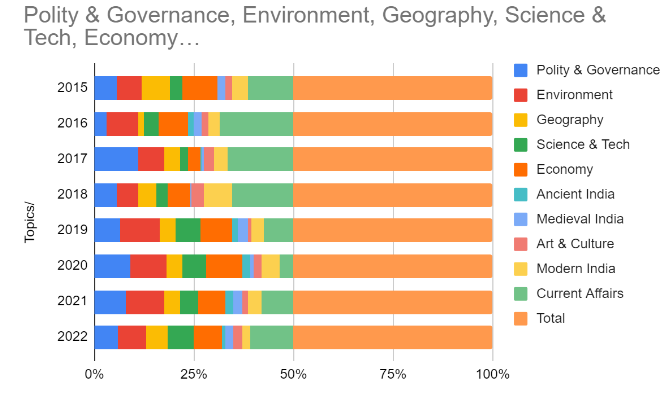
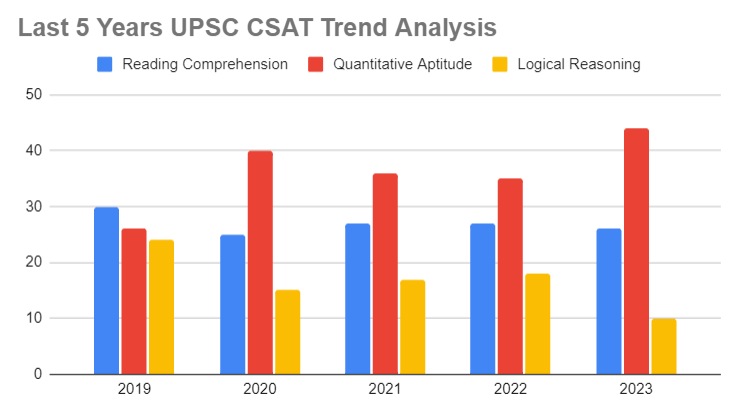
UPSC Prelims Exam Analysis 2025 FAQs
How to analyse the UPSC Prelims question paper?
Which is the toughest UPSC Prelims paper?
What is the best strategy for UPSC Prelims exam?
What is the most important subject for the UPSC Prelims exam?
Which is the hardest subject in the UPSC Prelims exam?






